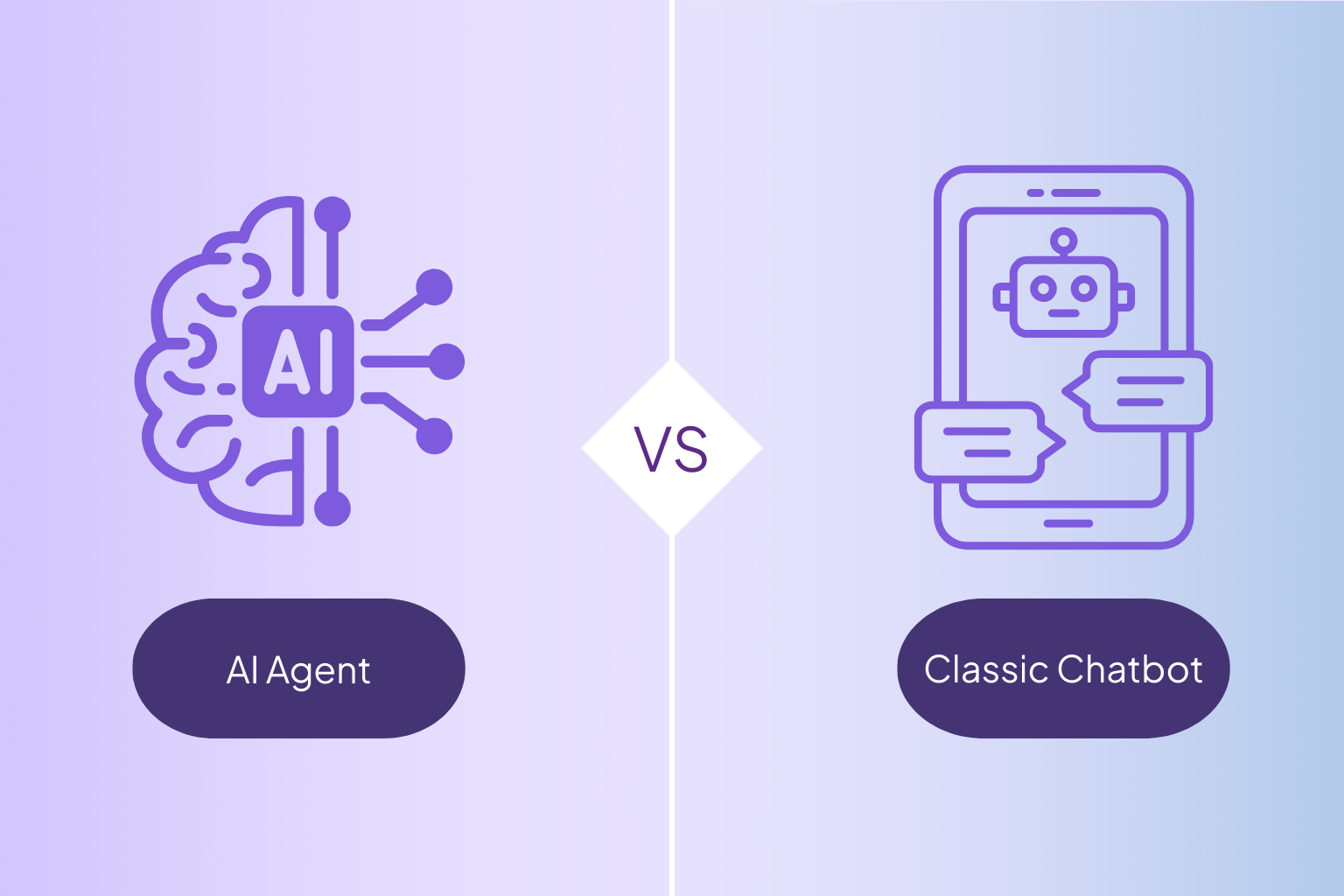AI Agents vs. Classic Chatbots – The Key Differences

Chatbots are now part of everyday life in many companies: they answer standard questions, forward inquiries, and support customer service. But with the rise of AI agents, the playing field is fundamentally changing.
In this article, we highlight the key differences between chatbots and AI agents – and show why AI agents represent a true paradigm shift for companies.
1. Functionality: Rules vs. Autonomy
- Classic chatbots: work with fixed decision trees or scripts. They can answer simple FAQs (“What is my customer number?”), but quickly reach their limits when requests become more complex or unpredictable.
- AI agents: are based on machine learning and large language models (LLMs). They respond contextually, combine information from different systems, and are able to make independent recommendations for action or trigger workflows.
Example:
- A chatbot can only refer to an FAQ when asked “Where is my package?”
- An AI agent, on the other hand, checks the shipment status in real time, detects delays, and proactively informs the customer about the next steps.
2. Data Access and Integration
The biggest difference lies in the depth of system integration:
- Chatbots: Usually only access static databases or FAQ documents.
- AI agents: are deeply integrated into enterprise systems (e.g., CRM, ERP, HR, ITSM, collaboration tools). They have access to live data and can generate individual responses or execute actions directly.
Example:
- A chatbot in e-commerce only tells the customer the return period.
- An AI agent simultaneously checks the purchase contract, automatically creates a return label, and initiates the refund in the ERP system.
👉 Result: Fewer media breaks, less effort – and a better customer experience.
3. User Interaction: Static vs. Natural
- Chatbots: provide standardized, often impersonal responses.
- AI agents: understand natural language, can conduct longer dialogs, and trigger actions in the background.
Example:
- A chatbot answers the question about the vacation policy only with a standard text.
- An HR agent analyzes the employee’s individual situation, compares it with the employment contract, and automatically provides the appropriate forms.
4. Flexibility and Learning Ability
- Chatbots: are static. Every new request requires manual maintenance in the rule set.
- AI agents: are dynamic and capable of learning. They improve their responses with every interaction, adapt to new data situations, and continuously expand their “knowledge.”
Example:
- A chatbot can only consider new legal changes after manual adjustment.
- A compliance agent, on the other hand, automatically scans new regulatory requirements and integrates them directly into its review processes.
This makes AI agents a scalable knowledge repository that becomes more valuable over time.
5. Business Impact: Efficiency Gains and Added Value
- Efficiency: Routine tasks are automated, employees have more time for value-adding activities.
- Error reduction: Automated workflows reduce manual input errors by up to 70%.
- Productivity: Studies show an average increase in employee productivity of 30–40%.
- Customer satisfaction: Personalized and faster responses significantly improve the customer experience.
Example:
An insurance company was able to reduce the processing time for claims by 60% with a multi-agent workflow – while simultaneously increasing customer satisfaction.
6. Market Trends: Why Companies Are Rethinking
According to Gartner, around 70% of all companies will use AI agents in core processes by 2026. The market for intelligent automation is growing at double-digit rates annually, as companies increasingly realize that chatbots alone are no longer sufficient.
Factors accelerating this trend:
- Hybrid work: Virtual assistants relieve employees in remote setups.
- Data explosion: AI agents handle complex, unstructured data.
- Customer expectations: Personalized, instant responses are becoming the standard.
7. Practical Examples in Comparison
- Customer Service: Chatbot gives FAQ answer → AI agent checks customer history, suggests individual solution, initiates process.
- Sales: Chatbot provides product info → AI agent qualifies lead, creates quote, sends follow-up.
- IT Support: Chatbot explains password reset → IT agent resets password, informs user, documents in ticket system.
These examples make it clear: AI agents are proactive, capable of action, and business-critical – chatbots are more like service tools.
Comparison Table
| Criterion | Traditional Chatbots | AI Agents |
| Flexibility | Low | High |
| Learning Capability | None | Yes |
| Data Access | Limited databases | Enterprise-wide systems |
| Decision-Making | Rule-based | AI-driven |
| Interaction | Standardized | Natural & proactive |
| Business Impact | Locally limited | Cross-functional, measurable |
Conclusion
The difference between classic chatbots and AI agents is not just technical – it changes the way companies work.
FAQ
Are AI agents an evolution of chatbots?
Can chatbots be replaced by AI agents?
Are AI agents more expensive to implement?
In the short term, yes, but in the long term, the savings from efficiency gains and error reduction outweigh the costs.
Where is their use particularly worthwhile?
Can AI agents be used in a GDPR-compliant way?
How do I start an AI agent project?
Download Whitepaper “Successfully Implementing Generative AI in Companies”.
Follow us on LinkedIn